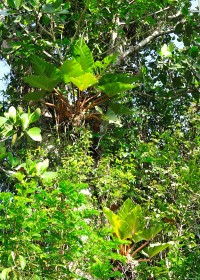Plant of the month
- Published:
- 10 May 2016
- Category:
- News
Decorative plants in the wild
Its name is well known to all. As soon as it is stated, our imagination is awakened and immediately transported into the world of tropical forests. It’s a green plant, sometimes very large, widely used for ornamental purposes for decorating houses worldwide. You have guessed, our choice for the plant of the month, the Philodendron. It is part of the Araceae family, as well as our emblem flower, Anaphyllopsis americana.
Etymologically, the name is derived from the Greek ‘friend of the trees’. This is related to the fact that many species live epiphytically. In the Trésor reserve, more than twenty species of Philodendron were inventoried, of which some are visible along our trails. Without making a full tour along the present species, here are a few whose appearance should be familiar to you.
Philodendron cordatum and Philodendron scandens have heart-shaped leaves when they are young, plated around large trees. The leaves of Philodendron placidum are disposed on only one side of the stem. The elongated leaves of Philodendron insigne can measure almost a meter. One of our larger specimens, Philodendron melinonii possesses very large, sturdy and heart-shaped leaves.
Some of the latter have just been planted near Trésor’s new entrance building for decoration. After all, in the reception area, we have the chance to expose them to you easily, giving you the first teasers of what you can find in the forest. Another philodendron accompanies: Philodendron goeldii, equally impressive in its size and recognizable by its large pinnate leaves. Remember to make them a little wink at your next ride.
Be interested also in their inflorescence, because the form is characteristic. They are adapted to attract and retain the insects that pollinate them. Indeed, the male flowers heat up and emit a heady fruity odour. The base of the inflorescence where the female flowers are located, turns into a ‘flower room’ in which insects can copulate and feed themselves. In the meanwhile, they incidentally carry pollen and disperse it by passing from one flower to another.


